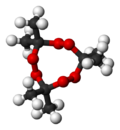Acetone peroxide
| Acetone peroxide | |
|---|---|
 
| |
| General | |
| Systematic name | Acetone peroxide |
| Other names | peroxyacetone Triac clay/tone tri peroxide, TATP Tricycloacetonperoxid, TCAP |
| Molecular formula | C6H12O4 (dimer) C9H18O6 (trimer) |
| SMILES | CC1(C)OOC(C)(C)OO1 (dimer) CC1(C)OOC(C)(C)OOC(C)(C)OO1 (trimer) |
| Molar mass | [[Molar mass::148.157 g/ml (dimer) 222.24 g/mol (trimer)]] |
| Appearance | White crystalline solid |
| CAS number | CAS number::17088-37-8 |
| Properties | |
| Solubility in water | Insoluble |
| Melting point | Melting point::91°C |
| Boiling point | Boiling point::97-160°C |
| Hazards | |
| Main hazards | explosive |
| R/S statement | R: 1, 3, 5, 6, 10 S: 2, 15, 16, 29 |
Acetone Peroxide is an organic chemical compound discovered in 1895 by Richard Wolffenson. It is very unstable and can explode very easily from heat, friction, and shock. It is easy to make, making it a favorite for extremist organizations. It is rarely used for industrial purposes because it is so dangerous.[1]
Properties
Acetone peroxide is a highly unstable compound, which is sensitive to shock, friction, and heat and will explode with minimal provocation. It is a high explosive but strangely does not contain nitrogen and is able to explode when wet or underwater. The name acetone peroxide usually alludes to the cyclic trimer form called TCAP or tri-cyclic acetone peroxide but it can refer to the cyclic dimer form referred to as TATP or di-cyclic acetone peroxide.[2] It has two common molecular formulas: The dimer form C6H12O4 and the trimer form C9H18O6. While the trimer is more stable than the dimer form, both must be handled with great care.[3] Relatively small amounts of acetone peroxide, such as 2 grams, will burn when put aflame but in quantities greater than this the substance will detonate. The substance gives off a "spicy"[4] aroma in the air. When left in the open air, the trimeric form of acetone peroxide, TCAP, will sublime, forming a different, larger crystal structure but remains the same peroxide. The violent and explosive decomposition of this substance has been described as an entropic explosion because its volume changes significantly without releasing very much heat.
Occurrences
Acetone peroxide does not occur naturally. It is commonly synthesized using acetone and hydrogen peroxide, two substances relatively easy to find. It is a very common and unwanted byproduct of oxidation reactions. For example, in the creation of fiberglass, substances are mixed with acetone and, if left sitting, will synthesize acetone peroxide. Measures are taken to curtail the production of this compound in reactions because of its hazards. Additionally, in one step of the synthesis of MDMA, or ecstasy, acetone peroxide is a byproduct.[5]
Uses
Because acetone peroxide is so easy to make and has explosive qualities, it is often utilized by terrorists. Although handling this substance has many risks associated with it, acetone peroxide is used in the bleaching and maturing of flour, along with benzoyl peroxide. It can be used for initiating polymerization reactions of such substances as silicon in the manufacture of fiberglass. [6]
Terrorism
Acetone peroxide is used frequently by terrorist organizations and is referred to as Mother of Satan by Islamic terror groups. It is utilized by groups such as Hamas and Al Qaeda to aid in their terror operations. It's used so widely by terrorists because it's main ingredients, bleach, acetone, and drain cleaner, are easy to obtain and do not arouse suspicion in the authorities. It is thought that this compound could have been used as a trigger or the main explosive in the London bombings. It is known that the trigger of the shoe bomb made by Briton Richard Reid on a plane from Paris to Miami was composed of acetone peroxide and was unsuccessfully detonated in 2001. Although its explosive properties and ease of synthesis have helped terrorists, it comes at a price. As attested by Palestinian extremists, many have died when handling the substance, lending to its nickname.[7]
References
- Acetone peroxide ChemistryDaily.com, Unknown author.
- Acetone peroxide Wikipedia.org, Multiple authors.
- Triacetone triperoxide Pubchem.ncbi.nlm.nih.gov, National Institute of Health
- TATP is suicide bombers' weapon of choice Naughton, Philippe. Timesonline.co.uk
- Acetone peroxide Economy-Point.org, June 24, 2006.
| ||||||||||||||


